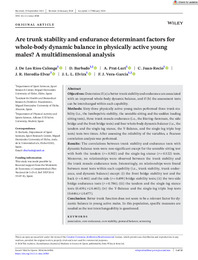Título :
Are trunk stability and endurance determinant factors for whole-body dynamic balance in physically active young males? A multidimensional analysis |
Autor :
De los Ríos Calonge, Javier
Prat-Luri, Amaya
Juan-Recio, Casto
Heredia-Elvar, Juan Ramón
López Elvira, José Luis
Vera García, Francisco J. |
Editor :
Wiley |
Departamento:
Departamentos de la UMH::Ciencias del Deporte |
Fecha de publicación:
2024 |
URI :
https://hdl.handle.net/11000/37926 |
Resumen :
Objectives
Determine if (a) a better trunk stability and endurance are associated with an improved whole-body dynamic balance, and if (b) the assessment tests can be interchanged within each capability.
Methods
Sixty-three physically active young males performed three trunk stability (i.e., the lumbopelvic stability, the unstable sitting and the sudden loading sitting tests), three trunk muscle endurance (i.e., the Biering–Sørensen, the side bridge and the front bridge tests) and four whole-body dynamic balance (i.e., the tandem and the single-leg stance, the Y-Balance, and the single-leg triple hop tests) tests two times. After assessing the reliability of the variables, a Pearson correlation analysis was performed.
Results
The correlations between trunk stability and endurance tests with dynamic balance tests were non-significant except for the unstable sitting test with both the tandem (r = 0.502) and the single-leg stance (r = 0.522) tests. Moreover, no relationships were observed between the trunk stability and the trunk muscle endurance tests. Interestingly, no relationships were found between most tests within each capability (i.e., trunk stability, trunk endurance, and dynamic balance) except: (i) the front bridge stability test and the back (r = 0.461) and the side (r = 0.499) bridge stability tests; (ii) the two side bridge endurance tests (r = 0.786); (iii) the tandem and the single-leg stance tests (0.439 ≤ r ≤ 0.463); (iv) the Y-Balance and the single-leg triple hop tests (0.446 ≤ r ≤ 0.477).
Conclusion
Better trunk function does not seem to be a relevant factor for dynamic balance in young active males. In this population, specific measures are needed as the test interchangeability is questioned.
|
Palabras clave/Materias:
Association
Core endurance
Core stability
Postural balance
Screening |
Área de conocimiento :
CDU: Bellas artes: Diversiones. Espectáculos. Cine. Teatro. Danza. Juegos.Deportes |
Tipo de documento :
info:eu-repo/semantics/article |
Derechos de acceso:
info:eu-repo/semantics/openAccess
Attribution-NonCommercial-NoDerivatives 4.0 Internacional |
DOI :
https://doi.org/10.1111/sms.14588 |
Publicado en:
Scandinavian Journal of Medicine & Science in Sports |
Aparece en las colecciones:
Artículos Ciencias del Deporte
|

 La licencia se describe como: Atribución-NonComercial-NoDerivada 4.0 Internacional.
La licencia se describe como: Atribución-NonComercial-NoDerivada 4.0 Internacional.
.png)